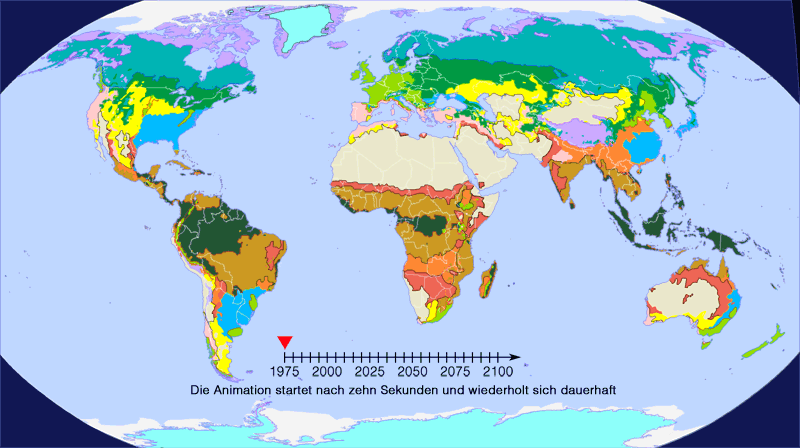Published 27 November 2015 by Stephanie Hanel
Why the Paris Climate Summit NEEDS to be a Success
The Earth has already warmed by one degree and this change has had a huge impact on many parts of the world. But what is the current situation? Is there any hope for a major shift in policy? And what does climate change have to do with civil wars?
First, let’s take a brief look at the scientific background to climate change. The link between the burning of fossil fuels (and therefore the emission of CO2 into the atmosphere) and global warming is nothing new. In fact, the Swedish physicist and chemist Svante August Arrhenius realised the importance of carbon dioxide for the Earth’s climate as early as the end of the 19th Century. The Nobel Prize-winning chemist devised his greenhouse gas theory in 1895. Regular recording of greenhouse gas began in 1957 when the US researcher Charles David Keeling began collecting data. The so-called Keeling Curve is widely seen as the first scientific evidence of man-made global warming and therefore the basis for current global climate research. Keeling’s measurements have been continuously collected ever since, with the exception of 1964. In 1988, the UN put together its Intergovernmental Panel on Climate Change (IPCC), tasking its expert members with recording the research findings of thousands of scientists worldwide.
In addition to CO2 emissions from the combustion of fossil fuels such as coal, oil and gas, which is thought to be responsible for around two thirds of climate change, global warming is also promoted by deforestation. Historically, around 70 percent of the world’s carbon has been stored in forests. A total of 20 percent of the current greenhouse gas emissions stem from the deforestation of huge swathes of forest, such as in South America and Indonesia. Industrial agriculture has also impacted negatively on climate change for various reasons.

The so-called “two-degree target” is based on scientific forecasts which predict incalculable changes if global warming were to exceed this mark. Scientists fear that a greater increase will change so-called tipping elements in the climatic system, in combination with other factors, and therefore dramatically accelerate climate change. Possible tipping elements include ice caps, rain forests and ocean currents.
Ban Ki-moon says #COP21 must be turning point towards a low-carbon, climate-resilient future https://t.co/WZEFQdaN3U pic.twitter.com/MJl0j6q56K
— Christiana Figueres (@CFigueres) 25. November 2015
This science forms the basis for global diplomatic and environment policy efforts. When asked whether the two-degree target is even achievable given the continued rise in CO2 emissions, the physicist Anders Levermann from the Potsdam Institute for Climate Impact Research (PIK) offered a very clear answer: “The two-degree target is technically possible. But society has to decide for itself whether it is economically and politically possible to move away from fossil fuels.” What is the current situation at international climate conferences? The so-called United Nations Framework Convention on Climate Change (UNFCCC) forms the basis for action on this matter, with 195 member states having signed up to date. The body’s secretariat, which is based in Bonn (Germany), has the same title. All member states obligate themselves to regularly publish reports on their current greenhouse gas emissions and come together every year for a ‘climate summit’. The upcoming summit in Paris is particularly important for the process of finally setting an obligatory climate target that every one of the member states has to adhere to. That is why this year’s conference has been preceded by several large-scale meetings on a scientific and political level. While a total of 164 states have already submitted written commitments, these would still be insufficient for achieving the two-degree target. Moreover, the countries worst effected by climate change are pushing for the enforcement of a 1.5-degree target.
2015 set to be warmest on record as climate change & #ElNiño join forces – @WMOnews https://t.co/es6DWJWgUl #COP21 pic.twitter.com/3U3lzHNFnu — United Nations (@UN) 25. November 2015
There is certainly no shortage of serious warnings as to what could happen if negotiations in Paris were to fail. The World Bank’s report from the start of November carried the telling title “Shock Waves. Managing the Impacts of Climate Change on Poverty” and claimed that if rapid action isn’t taken, a further 100 million people could slip into poverty by 2030. There can therefore be little doubt that climate change would create further increases in refugee flows in the future.
Sustained global warming will continued to promote the desertification of the Middle East, which will only serve to intensify social and political tensions in the region. In the case of the Syrian civil war, one study even suggests that climate change could have been a decisive trigger in the outbreak of violence. The civil war was preceded by an extremely dry period, which led to rural-urban migration and additional distribution and resource conflicts in the urban centres.
The task for the future is therefore to save liveable areas with suitable measures. Unfortunately, the summit was dramatically preceded by the deadly attacks in Paris on 13 November 2015. Due to the threat of terrorism, all large events surrounding the climate conference, such as demonstrations and concerts, have had to be cancelled for safety reasons.
No more excuses. It’s time to #ActOnClimate: https://t.co/XzQX5J0jpA pic.twitter.com/9mtCVvNiLx
— Barack Obama (@BarackObama) 23. November 2015
After the attacks, many leading politicians immediately emphasised that the threat of terrorism would not prevent them from taking part. But this commitment alone is not enough – they now have to be prepared to make uncomfortable decisions going forward.